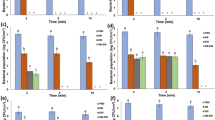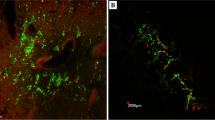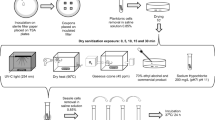Abstract
This study evaluated the chlorine dioxide (ClO2) gas mediated inactivation of the biofilm cells of foodborne pathogens on food contact surfaces. Biofilm cells of Escherichia coli O157:H7, Salmonella Typhimurium, and Listeria monocytogenes were developed on stainless steel (SS) and high density polyethylene (HDPE) coupon surfaces, and 5-day-old biofilms were treated with ClO2 gas at 60 and 90% relative humidity (RH) for up to 20 min. With an increase in gas concentration and treatment time, significant differences (p < 0.05) were observed between reduction levels under different RH conditions. Treatment with 50 ppmv of ClO2 gas (60% RH) for 20 min resulted in log reductions from 2.08 to 4.62 and 2.08 to 4.41 of the biofilm cells of three pathogens on SS and HDPE surfaces, respectively. The levels of biofilm cells of E. coli O157:H7, S. Typhimurium, and L. monocytogenes on SS and HDPE surfaces were reduced to below the detection limit (0.48 log CFU/cm2) within 15, 20, and 20 min, respectively, when exposure to 50 ppmv of ClO2 gas at 90% RH.
Similar content being viewed by others
Data availability
The authors confirm that the data supporting the findings of this study are available within the article.
Abbreviations
- SS:
-
Stainless steel
- HDPE:
-
High density polyethylene
- RH:
-
Relative humidity
- EPS:
-
Extra polymeric substances
- TSA:
-
Tryptic soy agar
- TSB:
-
Tryptic soy broth
- PBS:
-
Phosphate-buffered saline
- PW:
-
Peptone water
- SMAC:
-
Sorbitol MacConkey agar
- XLD:
-
Xylose Lysine Desoxycholate agar
- OAB:
-
Oxford agar base
References
Ban GH, Kang DH (2016) Effect of sanitizer combined with steam heating on the inactivation of foodborne pathogens in a biofilm on stainless steel. Food Microbiol 55:47–54
Ban GH, Yoon H, Kang DH (2014) A comparison of saturated steam and superheated steam for inactivation of Escherichia coli O157:H7, Salmonella Typhimurium, and Listeria monocytogenes biofilms on polyvinyl chloride and stainless steel. Food Control 40:344–350
Baumann AR, Martin SE, Feng H (2009) Removal of Listeria monocytogenes biofilms from stainless steel by use of ultrasound and ozone. J Food Prot 72:1306–1309
Bhagat A, Mahmoud BSM, Linton RH (2011) Effect of chlorine dioxide gas on Salmonella enterica inoculated on navel orange surfaces and its impact on the quality attributes of treated oranges. Foodborne Path Dis 8:77–85
Cappitelli F, Polo A, Villa F (2014) Biofilm formation in food processing environments is still poorly understood and controlled. Food Eng Rev 6:29–42
Chmielewski R, Frank J (2003) Biofilm formation and control in food processing facilities. Compr Rev Food Sci Food Saf 2:22–32
Cortés ME, Bonilla JC, Sinisterra RD (2011) Biofilm formation, control and novel strategies for eradication. Sci Against Microbial Pathog Commun Curr Res Technol Adv 2:896–905
Donlan RM, Costerton JW (2002) Biofilms: Survival mechanisms of clinically relevant microorganisms. Clin Microbiol Rev 15:167–193
Gora SL, Rauch KD, Ontiveros CC, Stoddart AK, Gagnon GA (2019) Inactivation of biofilm-bound Pseudomonas aeruginosa bacteria using UVC light emitting diodes (UVC LEDs). Water Res 151:193–202
Govaert M, Smet C, Baka M, Janssens T, Van Impe J (2018) Influence of incubation conditions on the formation of model biofilms by Listeria monocytogenes and Salmonella Typhimurium on abiotic surfaces. J Appl Microbiol 125:1890–1990
Govaert M, Smet C, Walsh JL, Van Impe JFM (2019) Dual-species model biofilm consisting of Listeria monocytogenes and Salmonella Typhimurium: development and inactivation with cold atmospheric plasma (CAP). Front Microbiol 10:2524
Gupta P, Sarkar S, Das B, Bhattacharjee S, Tribedi P (2016) Biofilm, pathogenesis and prevention—a journey to break the wall: a review. Arch Microbiol 198:1–15
Han Y, Floros JD, Linton RH, Nielsen SS, Nelson PE (2001) Response surface modeling for the inactivation of Escherichia coli O157:H7 on green peppers (Capsicum annuum L.) by chlorine dioxide gas treatments. J Food Prot 64:1128–1133
Kim WJ, Kim SH, Kang DH (2020) Thermal and non-thermal treatment effects on Staphylococcus aureus biofilms formed at different temperatures and maturation periods. Food Res Int 137:109432
Korany AM, Hua Z, Green T, Hanrahan I, El-Shinawy SH, El-Kholy A et al (2018) Efficacy of ozonated water, chlorine, chlorine dioxide, quaternary ammonium compounds and peroxyacetic acid against Listeria monocytogenes biofilm on polystyrene surfaces. Front Microbiol 9:2296
Li X, Kim MJ, Bang WS, Yuk HG (2018) Anti-biofilm effect of 405-nm LEDs against Listeria monocytogenes in simulated ready-to-eat fresh salmon storage conditions. Food Control 84:513–521
Linton RH, Han Y, Selby TL, Nelson PE (2006) Gas-/vapor-phase sanitation (decontamination) treatments. In: Sapers GM, Gorny JR, Yousef AE (eds) Microbiology of fruits and vegetables. CRC Press Press, Boca Raton, FL
Nam H, Seo HS, Bang J, Kim H, Beuchat LR, Ryu JH (2014) Efficacy of gaseous chlorine dioxide in inactivating Bacillus cereus spores attached to and in a biofilm on stainless steel. Int J Food Microbiol 188:122–127
Park SH, Kang DH (2015) Antimicrobial effect of chlorine dioxide gas against foodborne pathogens under differing conditions of relative humidity. LWT 60:186–191
Park SH, Kang DH (2017) Influence of surface properties of produce and food contact surfaces on the efficacy of chlorine dioxide gas for the inactivation of foodborne pathogens. Food Control 81:88–95
Park SH, Kim WJ, Kang DH (2018) Effect of relative humidity on inactivation of foodborne pathogens using chlorine dioxide gas and its residues on tomatoes. Lett Appl Microbiol 67:154–160
Srey S, Jahid IK, Ha SD (2013) Biofilm formation in food industries: a food safety concern. Food Control 31:572–585
Trinetta V, Linton RH, Morgan MT (2013) The application of high-concentration short-time chlorine dioxide treatment for selected specialty crops including Roma tomatoes (Lycopersicon esculentum), cantaloupes (Cucumis melo ssp. melo var. cantaloupensis) and strawberries (Fragaria × ananassa). Food Microbiol 34:296–302
U.S. Food and Drug Administration (FDA) Food Code (2017) Recommendations of the United States public health service and food and Drug administration. College Park, MD: U. S. Department of Health and Human Services. https://www.fda.gov/food/fda-food-code/food-code-2017. Accessed 27 June 2022
Vaid R, Linton RH, Morgan MT (2010) Comparison of inactivation of Listeria monocytogenes within a biofilm matrix using chlorine dioxide gas, aqueous chlorine dioxide and sodium hypochlorite treatments. Food Microbiol 27:979–984
Vandekinderen I, Devlieghere F, Van Camp J, Kerkaert B, Cucu T, Ragaert P et al (2009) Effects of food composition on the inactivation of foodborne microorganisms by chlorine dioxide. Int J Food Microbiol 131:138–144
Wang H, Cai L, Li Y, Xu X, Zhou G (2018) Biofilm formation by meat-borne Pseudomonas fluorescens on stainless steel and its resistance to disinfectants. Food Control 91:397–403
Wang R, Kalchayanand N, King DA, Luedtke BE, Bosilevac JM, Arthur TM (2014) Biofilm formation and sanitizer resistance of Escherichia coli O157:H7 strains isolated from “High Event Period” meat contamination. J Food Prot 77:1982–1987
Wei Q, Ma LZ (2013) Biofilm matrix and its regulation in Pseudomonas aeruginosa. Int J Mol Sci 14:20983–21005
Xue Z, Sendamangalam VR, Gruden CL, Seo Y (2012) Multiple roles of extracellular polymeric substances on resistance of biofilm and detached clusters. Environ Sci Technol 46:13212–13219
Acknowledgements
All bacterial strains used in this study were kindly provided by Dong-Hyun Kang (Department of Food Science and Biotechnology at Seoul National University). This research was financed by the National Research Foundation of Korea (NRF) and Korea Forest Service.
Funding
This work was supported by the National Research Foundation of Korea (NRF) Grant funded by the Korea government(MSIT) (NRF-2020R1F1A1048617). This study was carried out with the support of 'R&D Program for Forest Science Technology (Project No. 2021332C10-2123A01)' provided by Korea Forest Service (Korea Forestry Promotion Institute).
Author information
Authors and Affiliations
Contributions
All authors contributed to this manuscript as; S-YK: Investigation, Writing—original draft. S-HP: Conceptualization, Writing—review & editing, Resources, Supervision, Funding acquisition.
Corresponding author
Ethics declarations
Conflict of interest
The authors declare no conflict of interest.
Consent for publication
We hereby provide consent for publishing the results presented in this manuscript.
Additional information
Publisher’s Note
Springer Nature remains neutral with regard to jurisdictional claims in published maps and institutional affiliations.
Rights and permissions
Springer Nature or its licensor holds exclusive rights to this article under a publishing agreement with the author(s) or other rightsholder(s); author self-archiving of the accepted manuscript version of this article is solely governed by the terms of such publishing agreement and applicable law.
About this article
Cite this article
Kim, S., Park, S. Chlorine dioxide gas mediated inactivation of the biofilm cells of. J Food Sci Technol 59, 4863–4869 (2022). https://doi.org/10.1007/s13197-022-05574-2
Revised:
Accepted:
Published:
Issue Date:
DOI: https://doi.org/10.1007/s13197-022-05574-2




